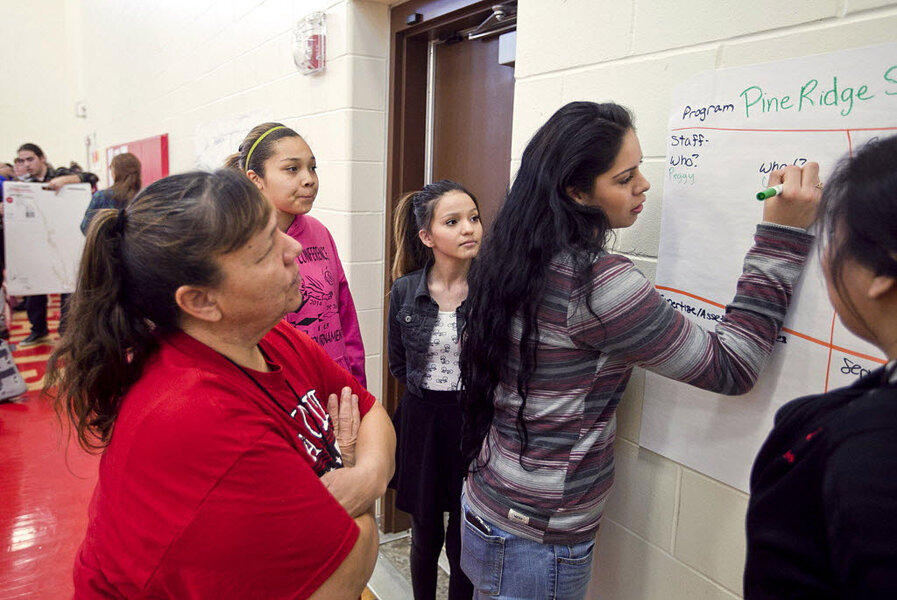Tribes battle high teen suicide rates on native American reservations
Loading...
Teen suicide has never been an easy issue for a community to grapple with, but the problem has become especially poignant for the Pine Ridge Indian Reservation.
On Monday, the Associated Press reported that a string of seven teen suicides in recent months has deeply affected the impoverished reservation, which spans a vast area along the South Dakota-Nebraska border.
"The situation has turned into an epidemic," Thomas Poor Bear, vice president of the Oglala Sioux Tribe, whose 24-year-old niece was one of two adults who also committed suicide this winter, told the Associated Press. "There are a lot of reasons behind it. The bullying at schools, the high unemployment rate. Parents need to discipline the children.”
Among native Americans ages 15 to 24, suicide rates are more than double the national average, the Monitor's Stacy Teicher Khadaroo reported. The suicides are taking place amid a host of social problems including alcoholism and drug abuse, bullying, violence, high unemployment and school dropout rates, and high levels of poverty and deprivation. Reversing a feeling of hopelessness is vital, advocates say.
Advocates stress that native American youth are a resilient group searching for solutions to their problems. But more federal resources are needed to address the deep-seated issues, they say.
“The federal government made promises that it isn’t meeting. It isn’t an accident that these communities are having problems. There is a history of trauma, of genocide. In exchange for land we promised them services and we’ve chronically underfunded them. But this is a community full of inspiring and resilient young people, but they don’t have equal access to opportunities,” says Erin Bailey, executive director of the Center for Native American Youth at the Aspen Institute.
Suicide is the second leading cause of death for American Indian/Alaskan Native youth, according to the Center, and native teens have the highest suicide rates of any population group in the US.
One initiative on the Pine Ridge Reservation that aims to use the community’s cultural heritage to prevent suicide is a program called Sweetgrass, which draws on traditional tribal values to teach people how to respond when someone is suicidal. The program focuses on tribal concepts such as Wowaunsila, having compassion for others, and Wokigna, comforting people who are experiencing psychic pain, to interact with individuals who have suicidal tendencies. These activities are especially important in isolated areas where it may take over an hour for emergency personnel to respond to a call, the center’s website says.
A number of tribes are using their traditions and cultural identity as a means of reaching at-risk youth. For example, on the neighboring Rosebud Reservation in South Dakota, staff in a reservation-run juvenile detention facility use tribal traditions to rehabilitate juvenile offenders.
“We are trying to integrate traditional Lakota cultural information, and rehabilitate our youth by bridging the gaps they might have with their identities and who they are,” Miskoo Petite, who runs the program, told The Washington Post.
But more resources are needed to address the problems that have been afflicting tribal communities for generations, advocates say, pointing to chronic underfunding by the government.
For one thing, Native American youth make up a larger percentage of the population. There are 1.2 million American Indian and Alaska Native young people under the age of 25 – 42 percent of the population, according to data from the National Congress of American Indians. That's compared with 34 percent of the total US population under 25. And almost one-third – 32.4 percent – of native American youth under 18 live in poverty, according to the NCAI Policy Research Center.
Meanwhile, unemployment among native Americans is almost double that of the rest of the population, US News & World Report reported.
Almost 1,000 suicide attempts were recorded on the Pine Ridge reservation between 2004 and 2013, the Associated Press reported. And the recent string of teen suicides on Pine Ridge has also transpired on other reservations across the country in previous years. On the Rosebud Reservation, 47 teenagers committed suicide over a two year period and at least two children a day are victims of a crime or exposed to abuse, neglect, or violence in school, the Washington Post reported in November.
Despite the bleak picture, attention from high-profile supporters has made some tribal leaders hopeful that the government will begin to recognize the scope of their needs, Ms. Bailey says.
During a recent event organized by the United National Indian Tribal Youth, first lady Michelle Obama said that the problems faced by many native American communities are due to historical grievances that should be addressed.
“You see, we need to be very clear about where the challenges in this community first started. Folks in Indian Country didn’t just wake up one day with addiction problems. Poverty and violence didn’t just randomly happen to this community. These issues are the result of a long history of systematic discrimination and abuse,” Mrs. Obama said.
“Supporting these young people isn’t just a nice thing to do, and it isn’t just a smart investment in their future, it is a solemn obligation that we as a nation have incurred.”








